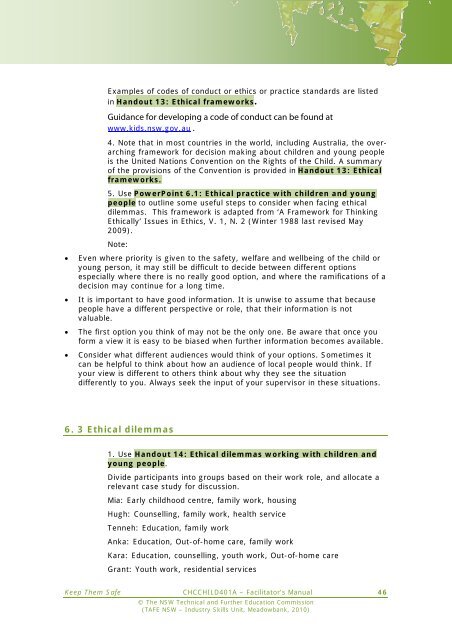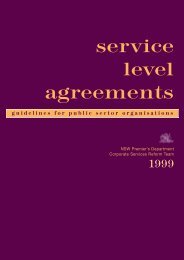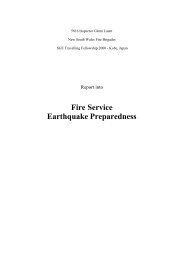Identify and respond to children and young people at risk - NSW ...
Identify and respond to children and young people at risk - NSW ...
Identify and respond to children and young people at risk - NSW ...
You also want an ePaper? Increase the reach of your titles
YUMPU automatically turns print PDFs into web optimized ePapers that Google loves.
Examples of codes of conduct or ethics or practice st<strong>and</strong>ards are listed<br />
in H<strong>and</strong>out 13: Ethical frameworks.<br />
Guidance for developing a code of conduct can be found <strong>at</strong><br />
www.kids.nsw.gov.au .<br />
4. Note th<strong>at</strong> in most countries in the world, including Australia, the overarching<br />
framework for decision making about <strong>children</strong> <strong>and</strong> <strong>young</strong> <strong>people</strong><br />
is the United N<strong>at</strong>ions Convention on the Rights of the Child. A summary<br />
of the provisions of the Convention is provided in H<strong>and</strong>out 13: Ethical<br />
frameworks.<br />
5. Use PowerPoint 6.1: Ethical practice with <strong>children</strong> <strong>and</strong> <strong>young</strong><br />
<strong>people</strong> <strong>to</strong> outline some useful steps <strong>to</strong> consider when facing ethical<br />
dilemmas. This framework is adapted from ‘A Framework for Thinking<br />
Ethically’ Issues in Ethics, V. 1, N. 2 (Winter 1988 last revised May<br />
2009).<br />
Note:<br />
Even where priority is given <strong>to</strong> the safety, welfare <strong>and</strong> wellbeing of the child or<br />
<strong>young</strong> person, it may still be difficult <strong>to</strong> decide between different options<br />
especially where there is no really good option, <strong>and</strong> where the ramific<strong>at</strong>ions of a<br />
decision may continue for a long time.<br />
It is important <strong>to</strong> have good inform<strong>at</strong>ion. It is unwise <strong>to</strong> assume th<strong>at</strong> because<br />
<strong>people</strong> have a different perspective or role, th<strong>at</strong> their inform<strong>at</strong>ion is not<br />
valuable.<br />
The first option you think of may not be the only one. Be aware th<strong>at</strong> once you<br />
form a view it is easy <strong>to</strong> be biased when further inform<strong>at</strong>ion becomes available.<br />
Consider wh<strong>at</strong> different audiences would think of your options. Sometimes it<br />
can be helpful <strong>to</strong> think about how an audience of local <strong>people</strong> would think. If<br />
your view is different <strong>to</strong> others think about why they see the situ<strong>at</strong>ion<br />
differently <strong>to</strong> you. Always seek the input of your supervisor in these situ<strong>at</strong>ions.<br />
6. 3 Ethical dilemmas<br />
1. Use H<strong>and</strong>out 14: Ethical dilemmas working with <strong>children</strong> <strong>and</strong><br />
<strong>young</strong> <strong>people</strong>.<br />
Divide participants in<strong>to</strong> groups based on their work role, <strong>and</strong> alloc<strong>at</strong>e a<br />
relevant case study for discussion.<br />
Mia: Early childhood centre, family work, housing<br />
Hugh: Counselling, family work, health service<br />
Tenneh: Educ<strong>at</strong>ion, family work<br />
Anka: Educ<strong>at</strong>ion, Out-of-home care, family work<br />
Kara: Educ<strong>at</strong>ion, counselling, youth work, Out-of-home care<br />
Grant: Youth work, residential services<br />
Keep Them Safe CHCCHILD401A – Facilita<strong>to</strong>r’s Manual<br />
© The <strong>NSW</strong> Technical <strong>and</strong> Further Educ<strong>at</strong>ion Commission<br />
(TAFE <strong>NSW</strong> – Industry Skills Unit, Meadowbank, 2010)<br />
46







